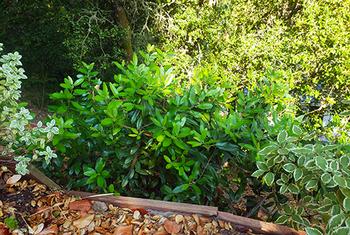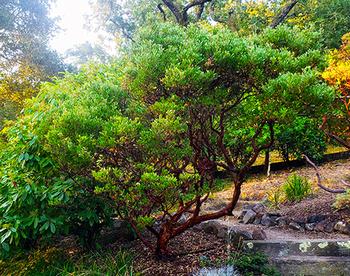Fall 2023
Aesthetic Pruning: Taking pruning a step further
by Hedwig Van Den Broeck
Introductory note: We highly recommend reading ‘Plant Native Shrubs Now for Winter and Spring Bloom’ and ‘Pruning to Control Growth’ in this Fall issue first as this article elaborates on both topics.
There is something magical about strolling through nature, where fauna and flora thrive without human interference. Our California natives - whether groundcovers, shrubs, or trees - just appear to be having a great time doing what they do best: growing effortlessly.

Madrones, nicknamed refrigerator trees, shed all their bark during summer. The deep red gives way to an exceptionally smooth green trunk. If you place your hand where the bark has peeled, the tree feels cold to the touch. Not only is this a very beautiful CA native tree, it is also a desired tree for wildlife. Birds relish Madrone berries, and raccoons, deer, and other wildlife passing by, eat them as well. This tree also provides good habitat and nesting places for many bird species. Madrones can be found naturally at the edge of many of our forests where they will always compete with surrounding trees for more light. Arbutus menziesii is often confused with Abutus unido. Both are cousins in the Ericaceae (Heath) family.
https://ipm.ucanr.edu/PMG/GARDEN/PLANTS/madrone.html
https://calscape.org/Arbutus-menziesii-(Madrone)
Doing the proper research was important. After delving into websites like Calscape.com and the UCANR website, I consulted a certified arborist and aesthetic pruner. Aesthetic pruning is defined as a ‘form of living art blending the artistic ability of the pruner, the essence of a tree, horticultural science, and the needs of customers and the environment’ (www.aestheticprunersassociation.org).

Other Ca native trees, such as Toyon, Arbutus Unedo, and many different varieties of Manzanita, can benefit from this practice as well. It is important however to carefully follow pruning instructions for the specific tree you wish to prune; proper cuts, necessary tools, best time of year to prune, preventing disease and infection, etc.
- When growing older, tall growing Manzanita tends to only stay green at the top and produce a lot of dead undergrowth. You will be amazed at how beautiful these Manzanitas look after trimming, with their interesting dark twisted branches becoming more visible and looking almost like garden sculptures. Trimming Manzanitas (like many other trees) also makes these trees and shrubs much more fire-safe. Keep in mind, however, that Manzanitas do not produce new leaves when you cut into a bare branch.
 Manzanita pruned. Photo by Hedwig Van Den Broeck.
Manzanita pruned. Photo by Hedwig Van Den Broeck. - Toyon is very forgiving when pruning; in fact, you can cut it all the way down to the ground if needed. They will grow back, and when they do, you can change their shape, keep them low growing, or trim Toyon into a hedge.

More resources:
https://www.cnps.org/gardening/pruning-native-plants-4033
https://ucanr.edu/blogs/blogcore/postdetail.cfm?postnum=39078
https://ccmg.ucanr.edu/News_to_Grow_By/?story=2510

